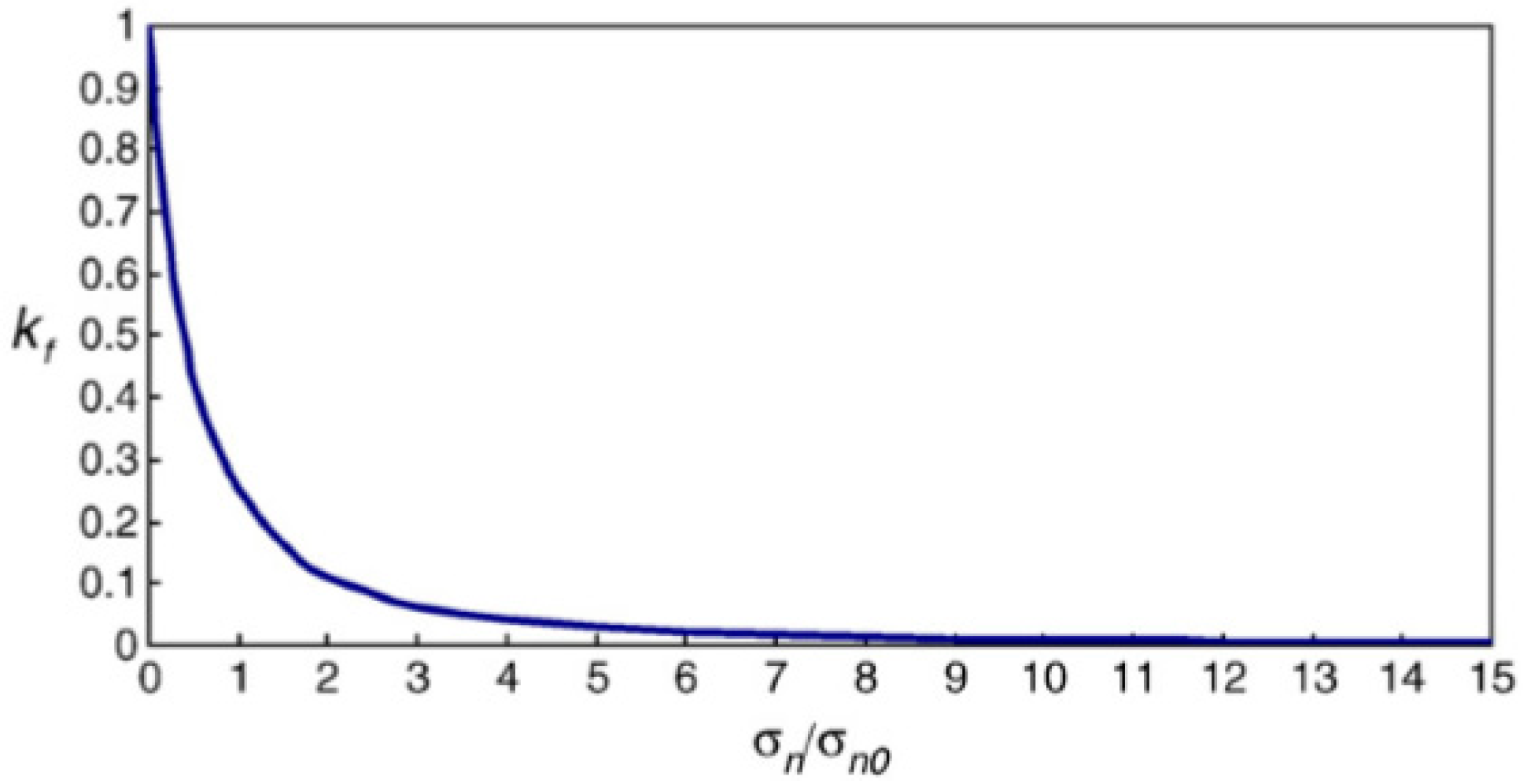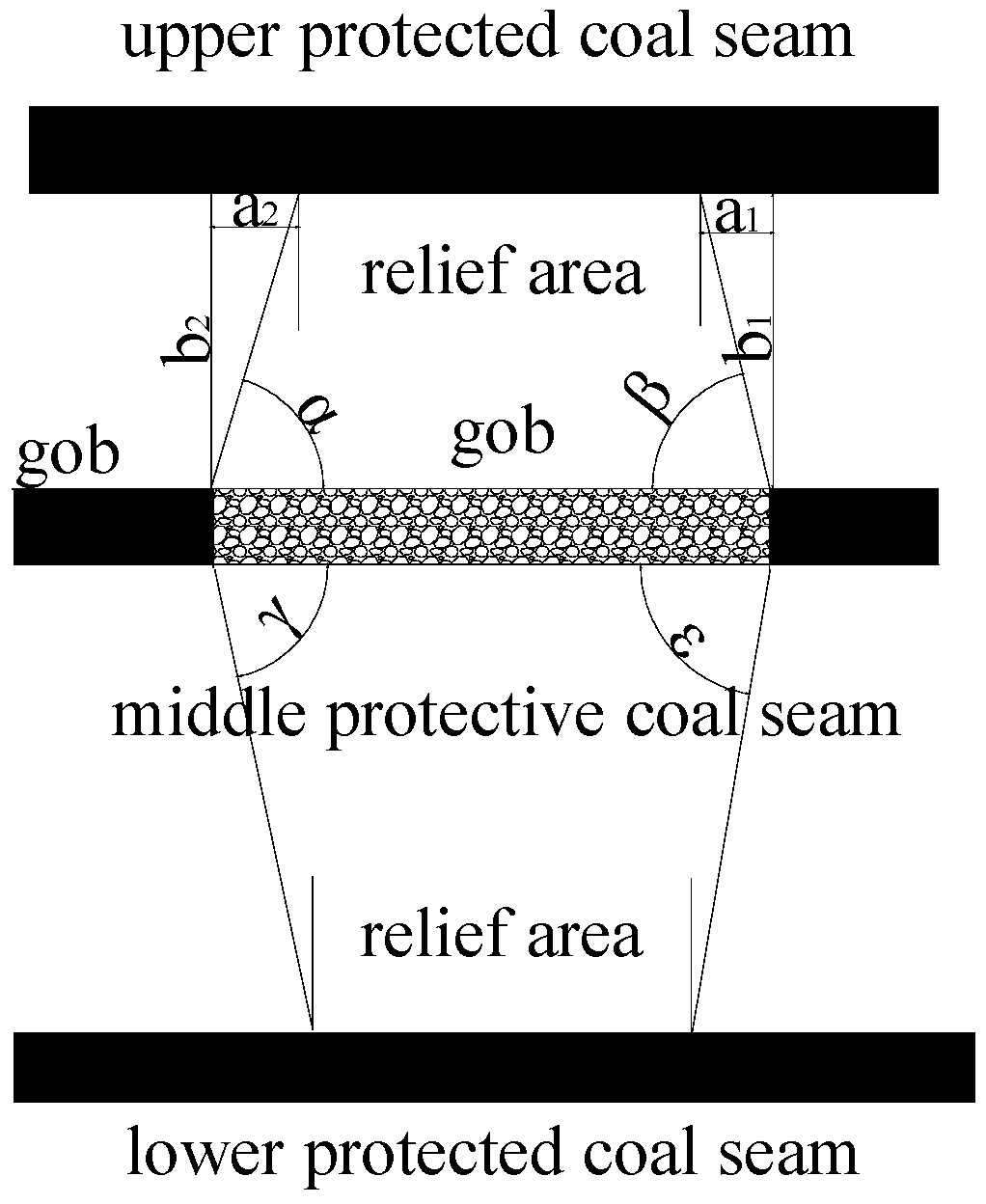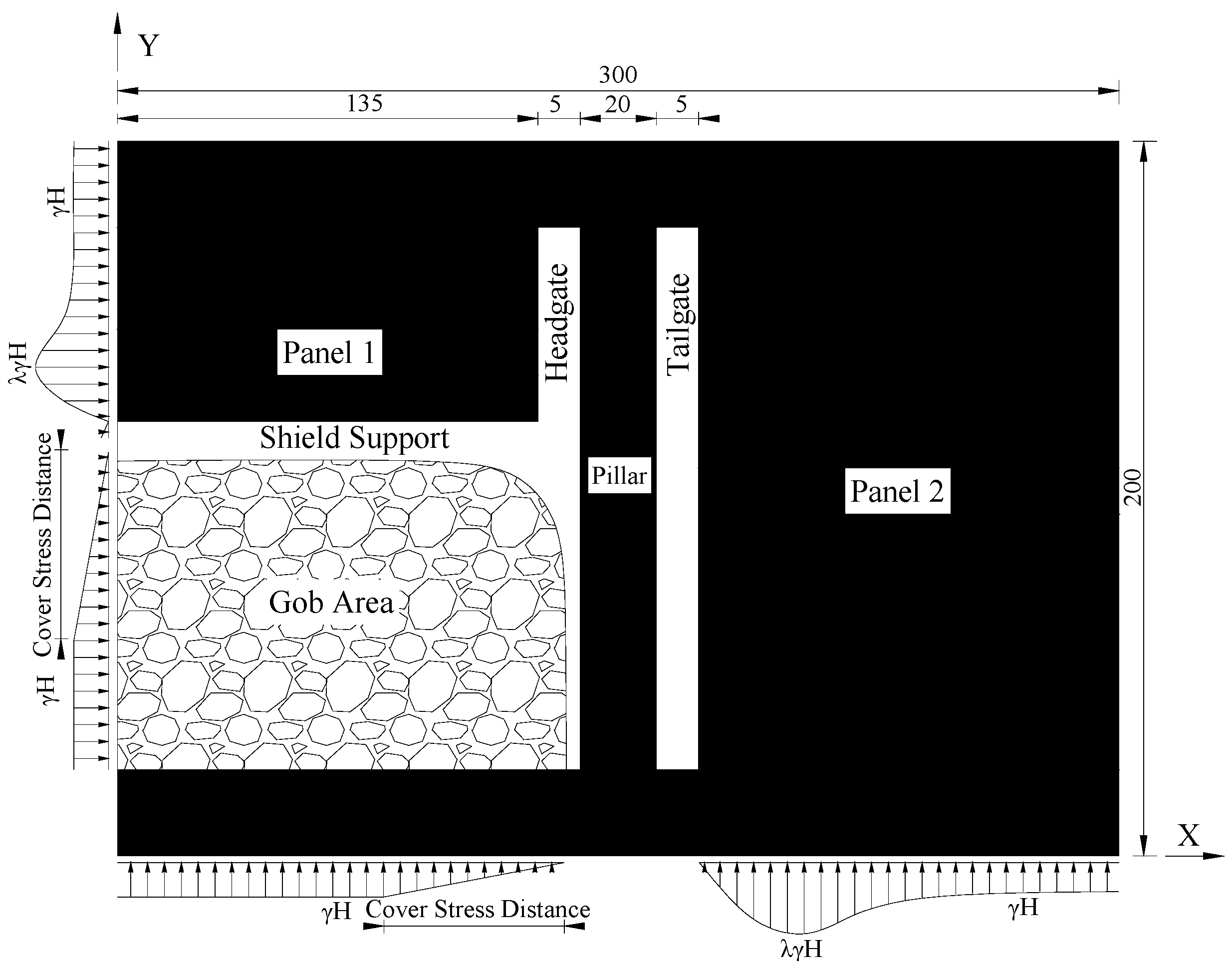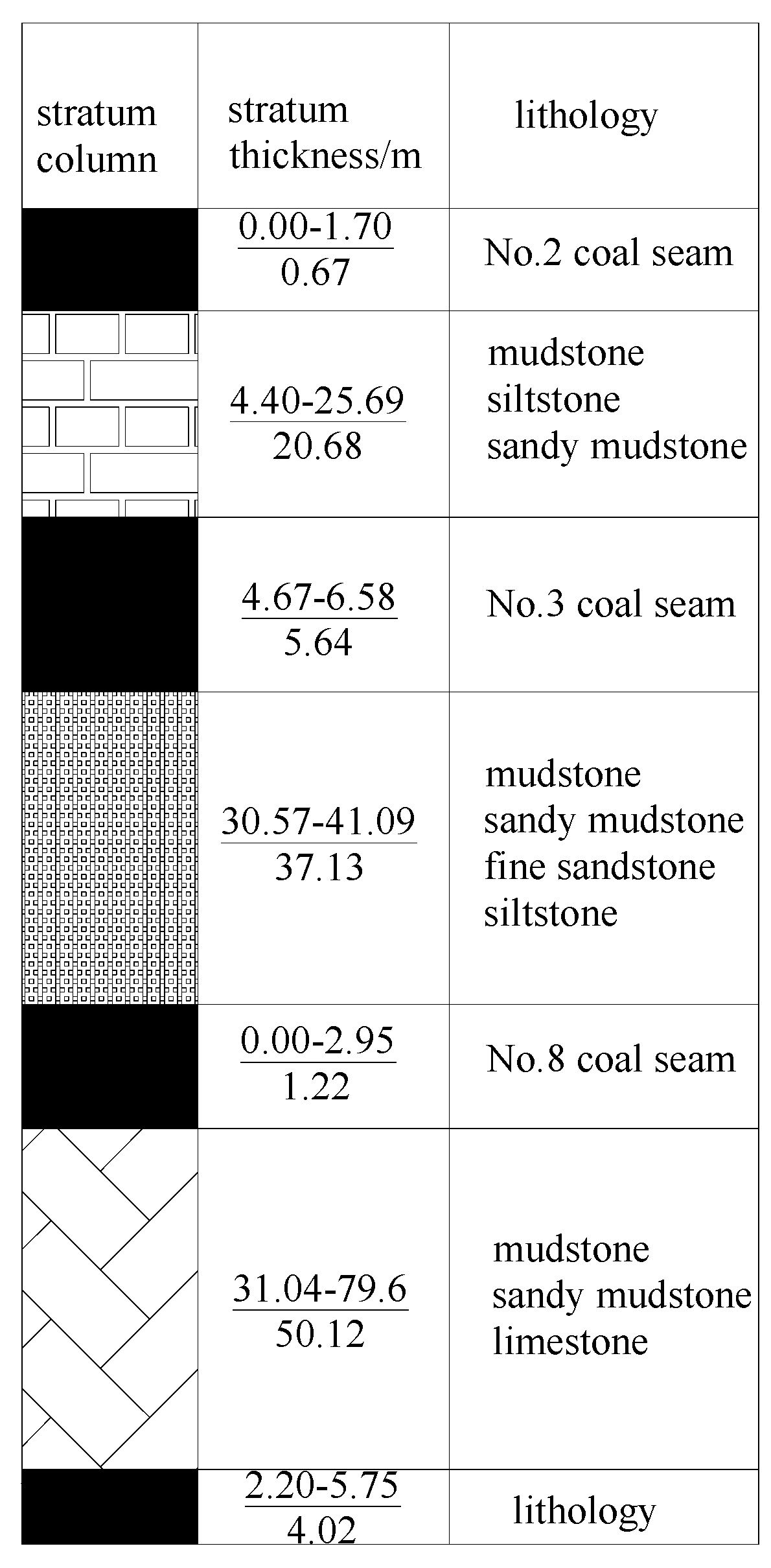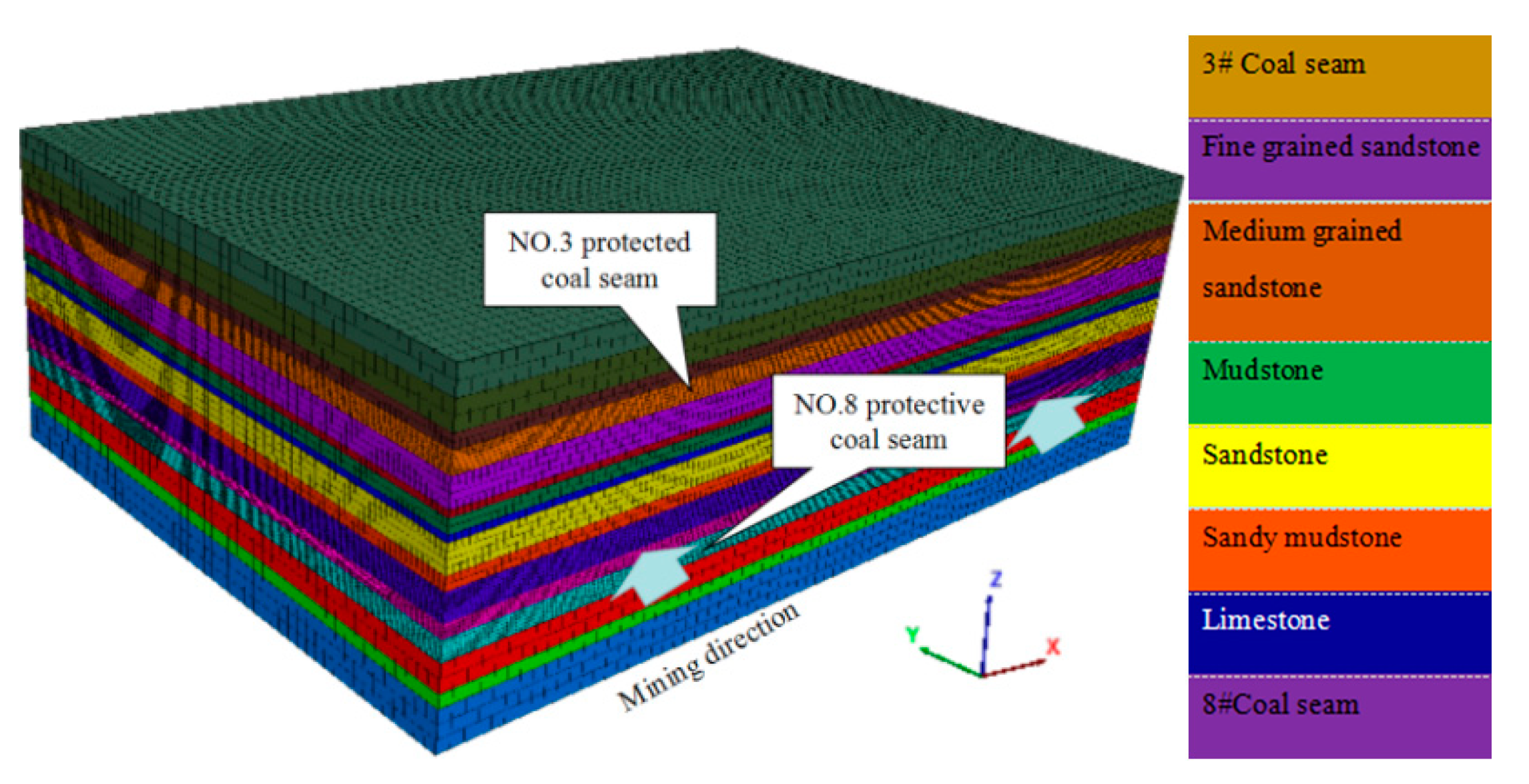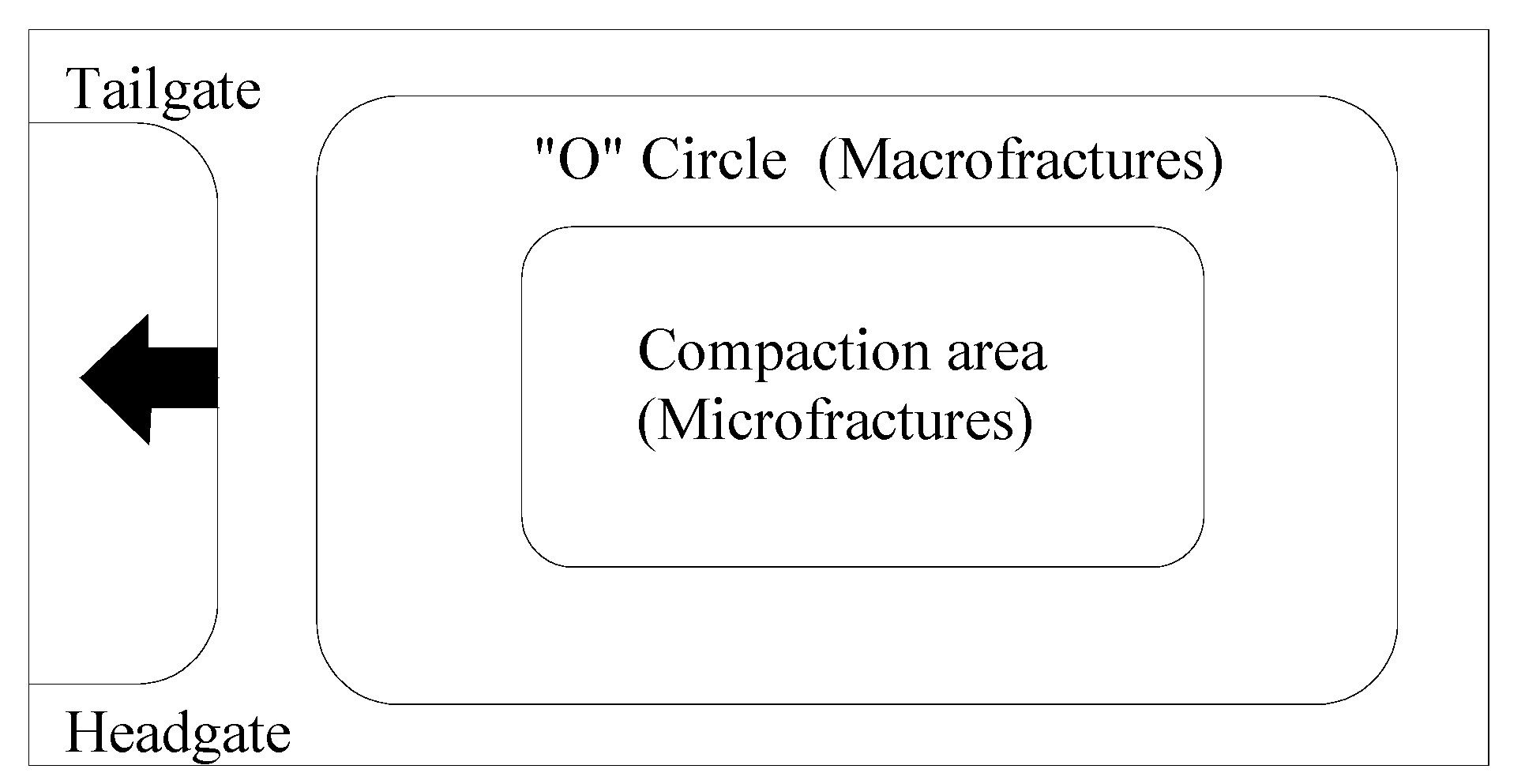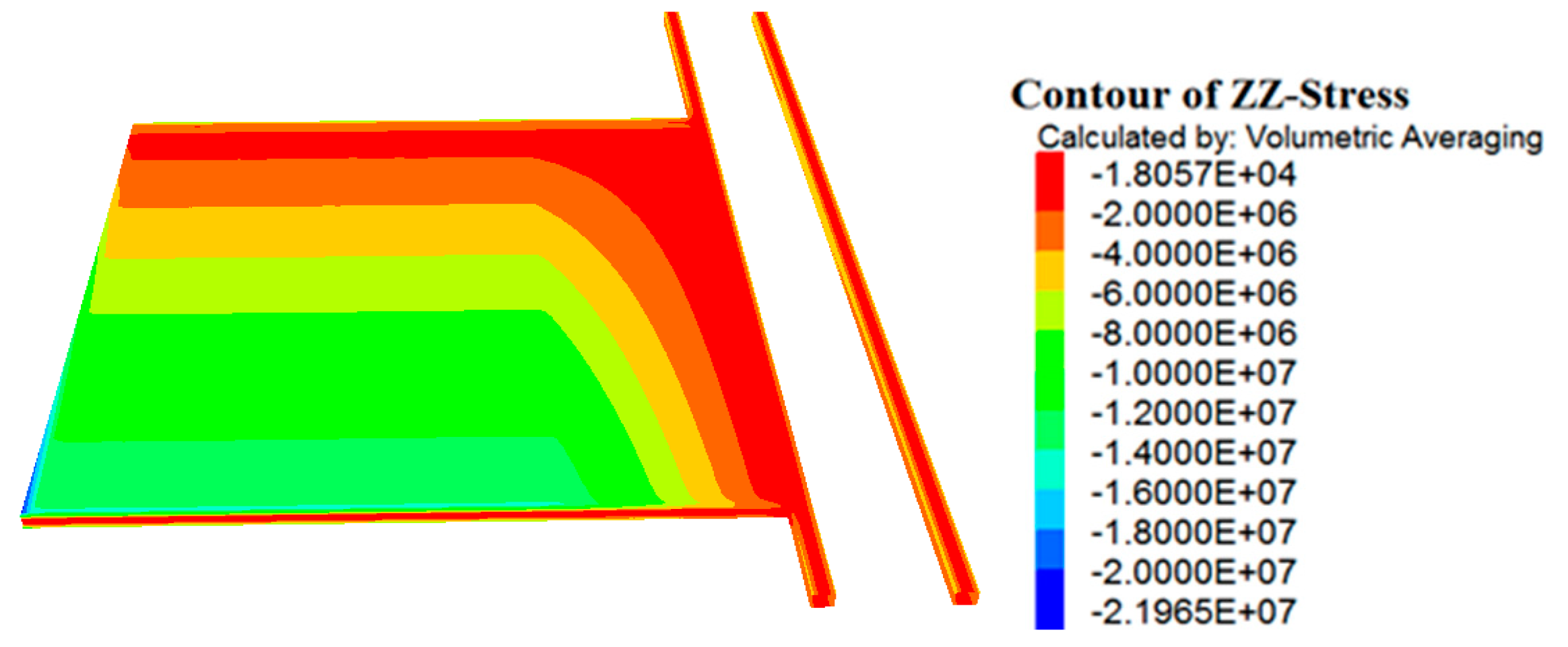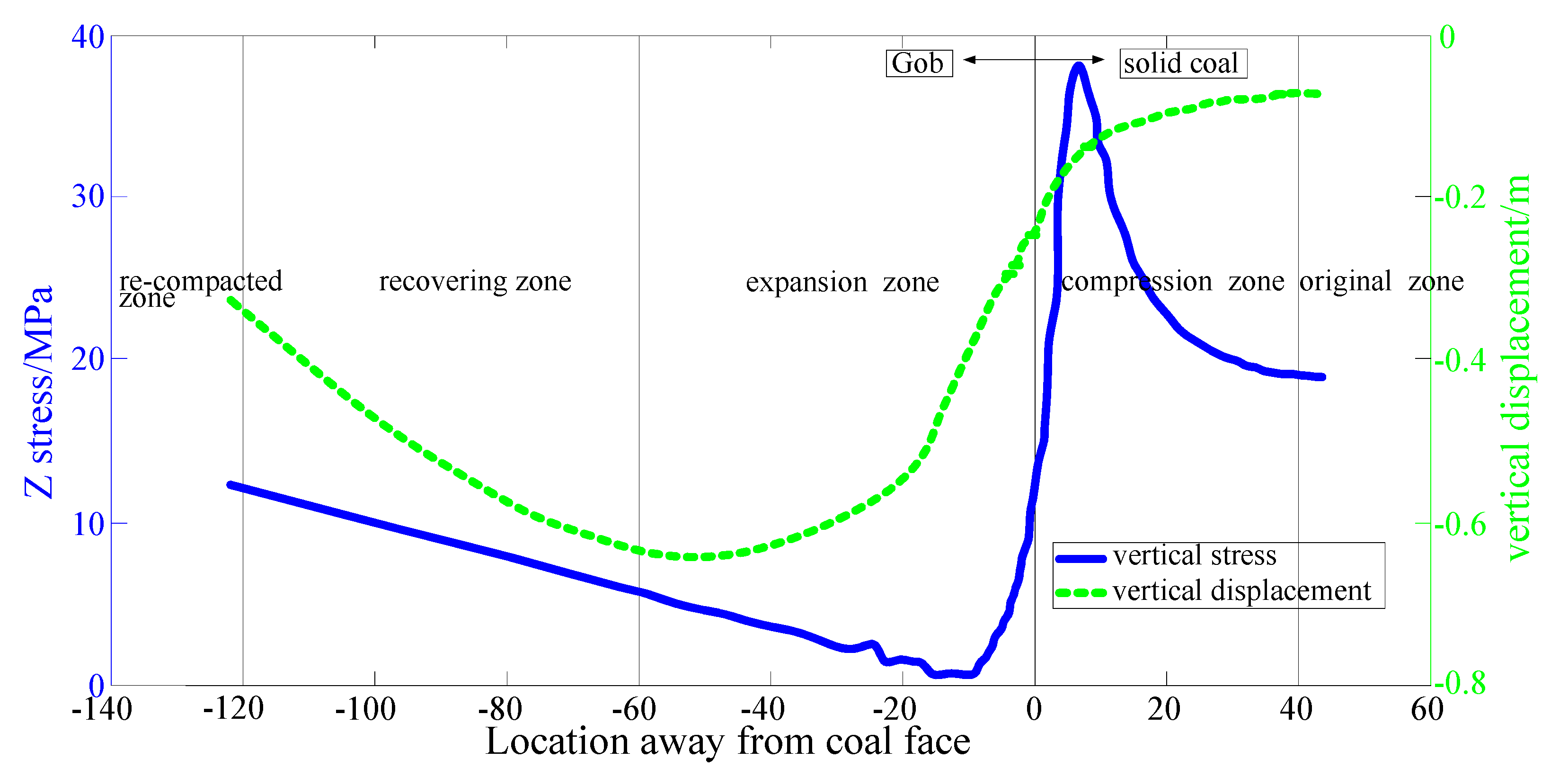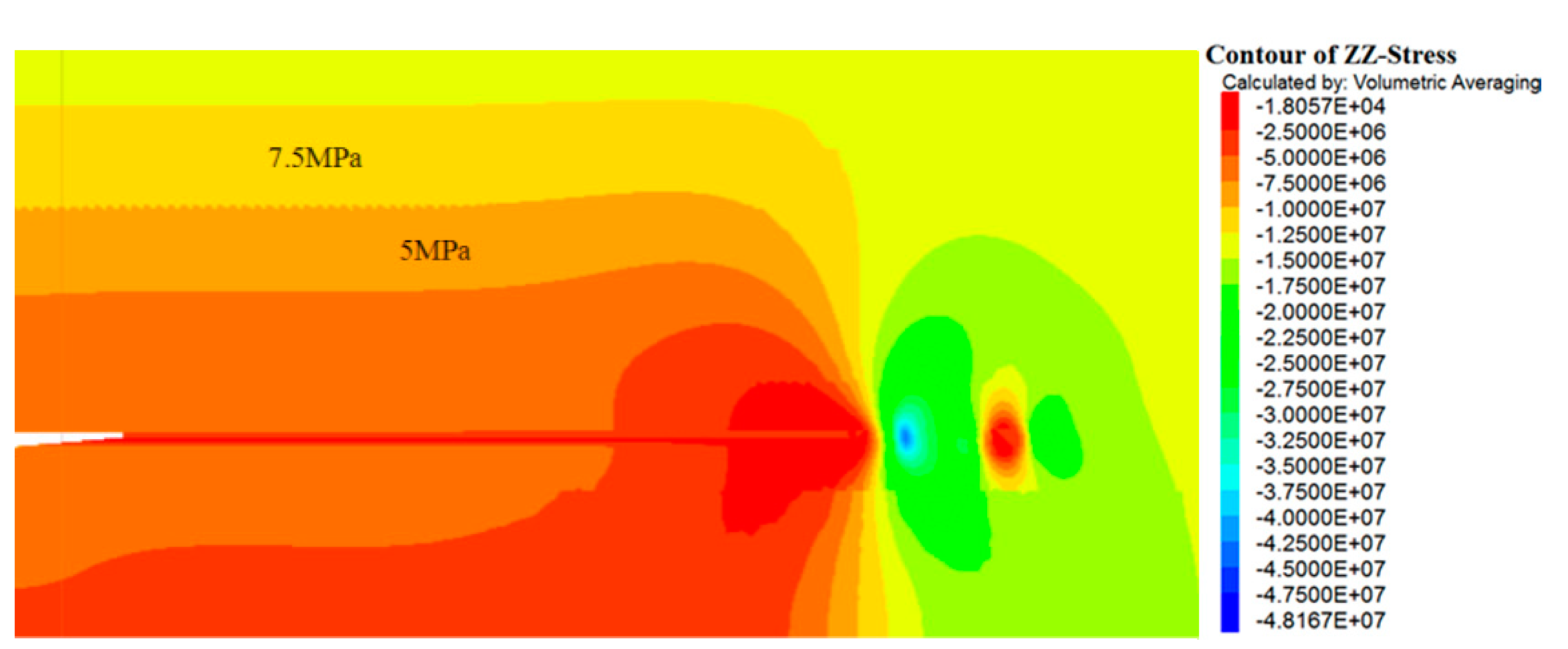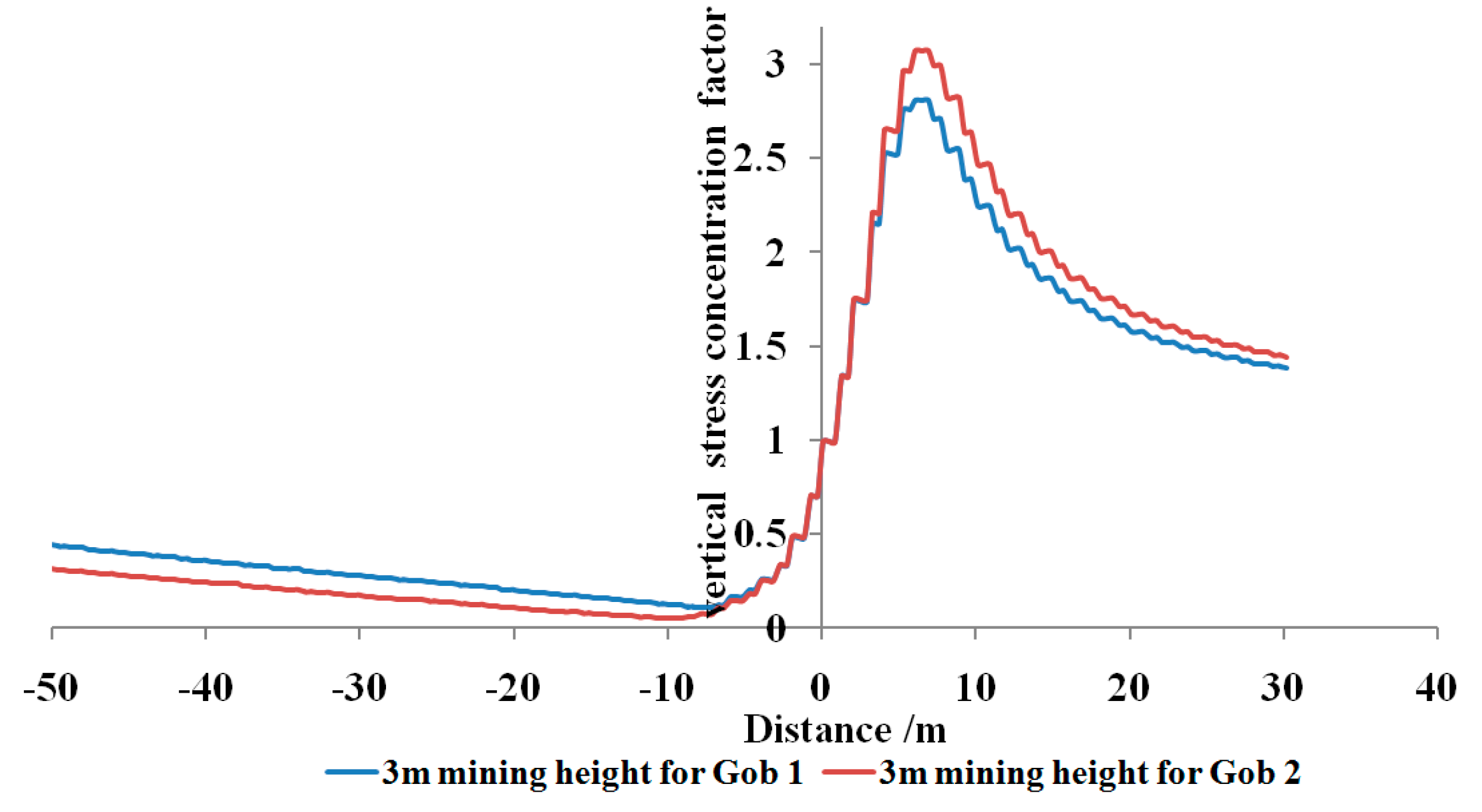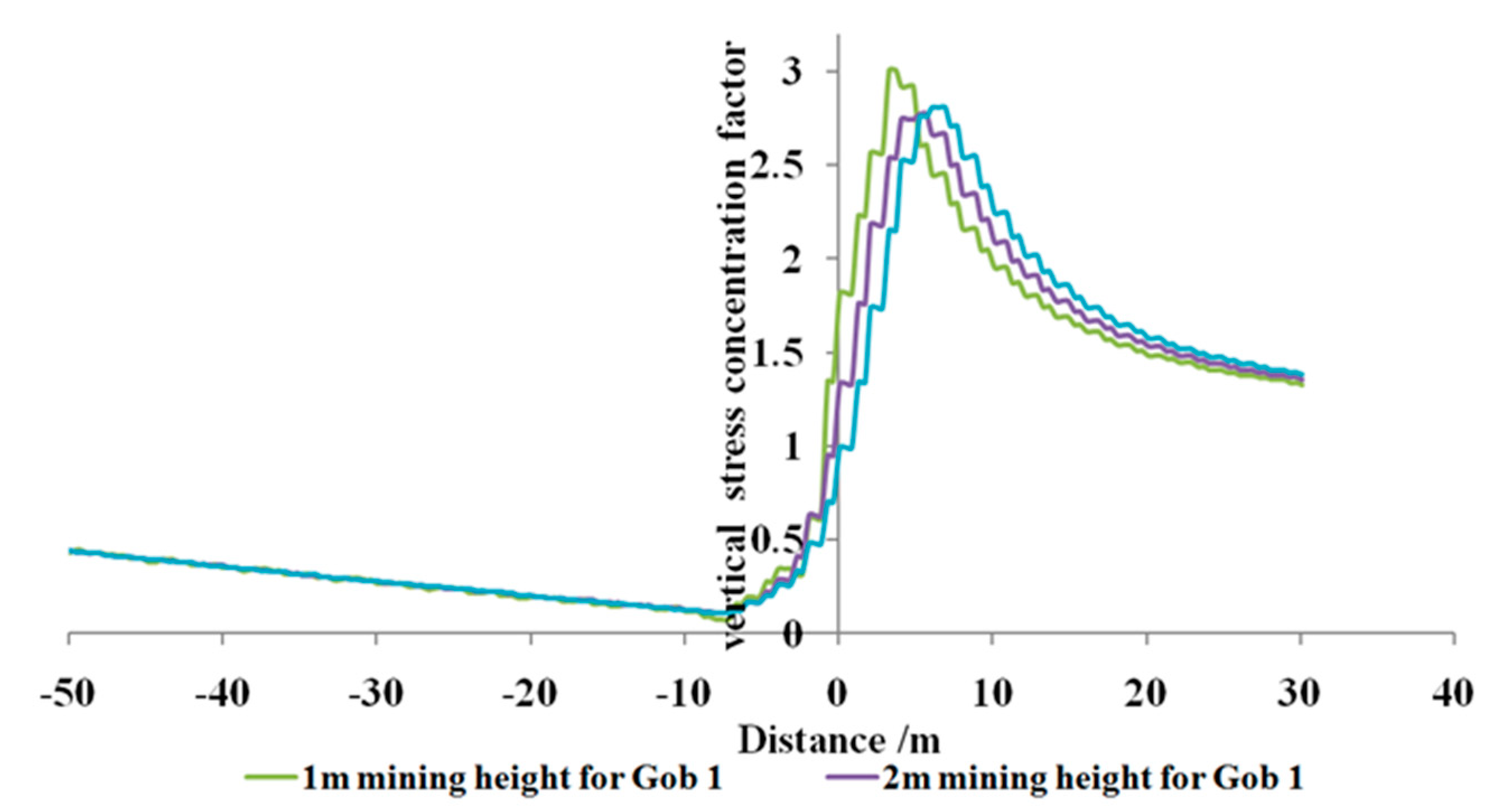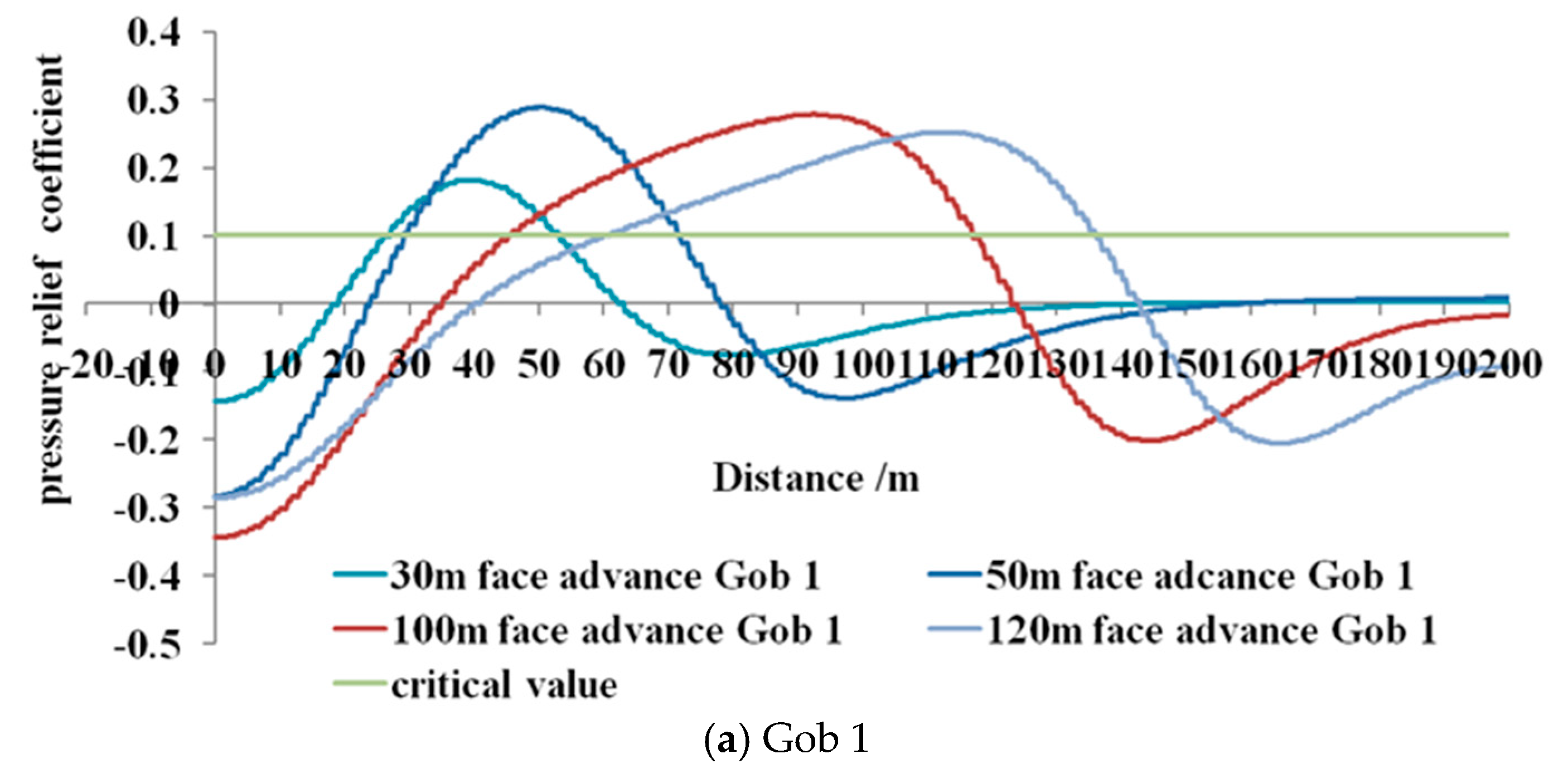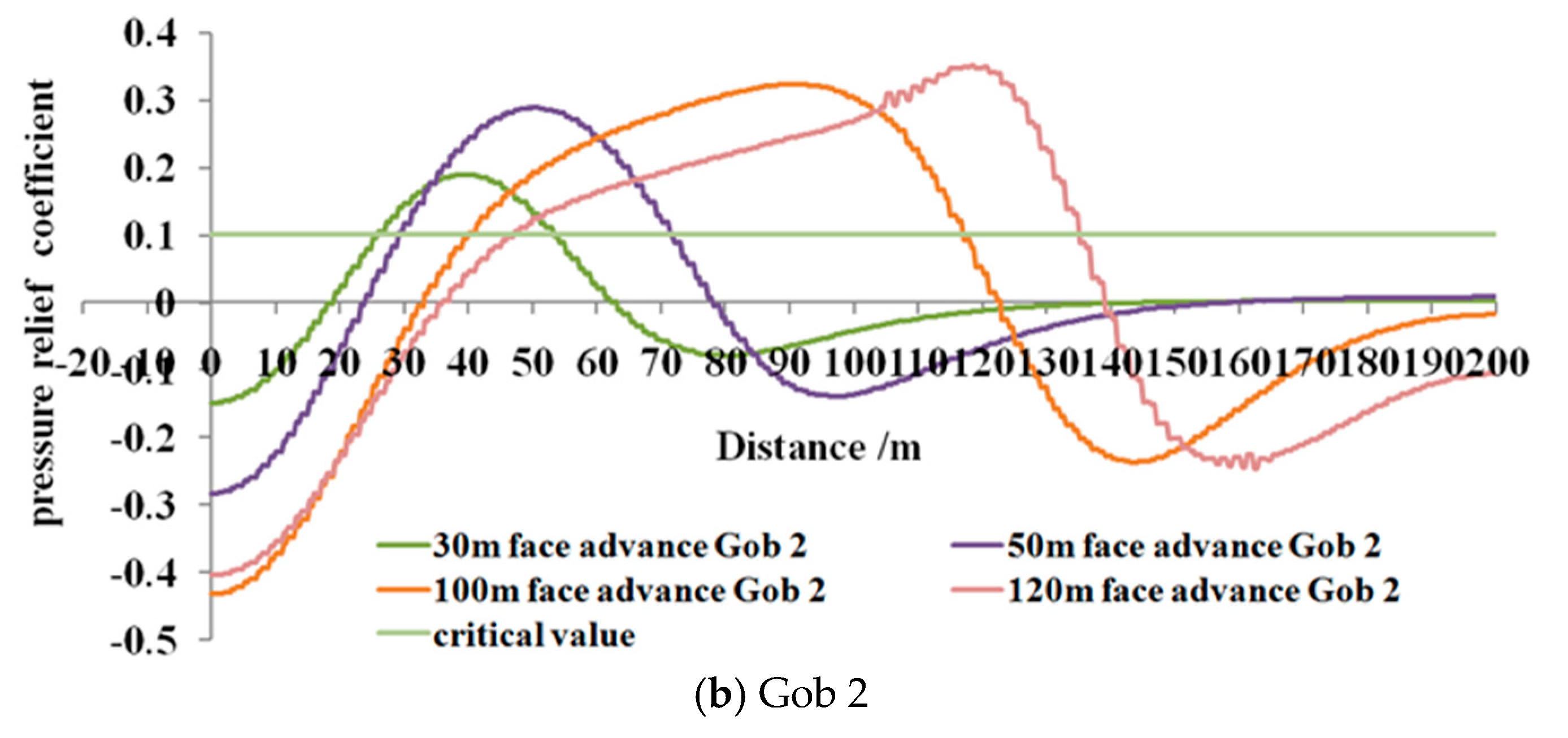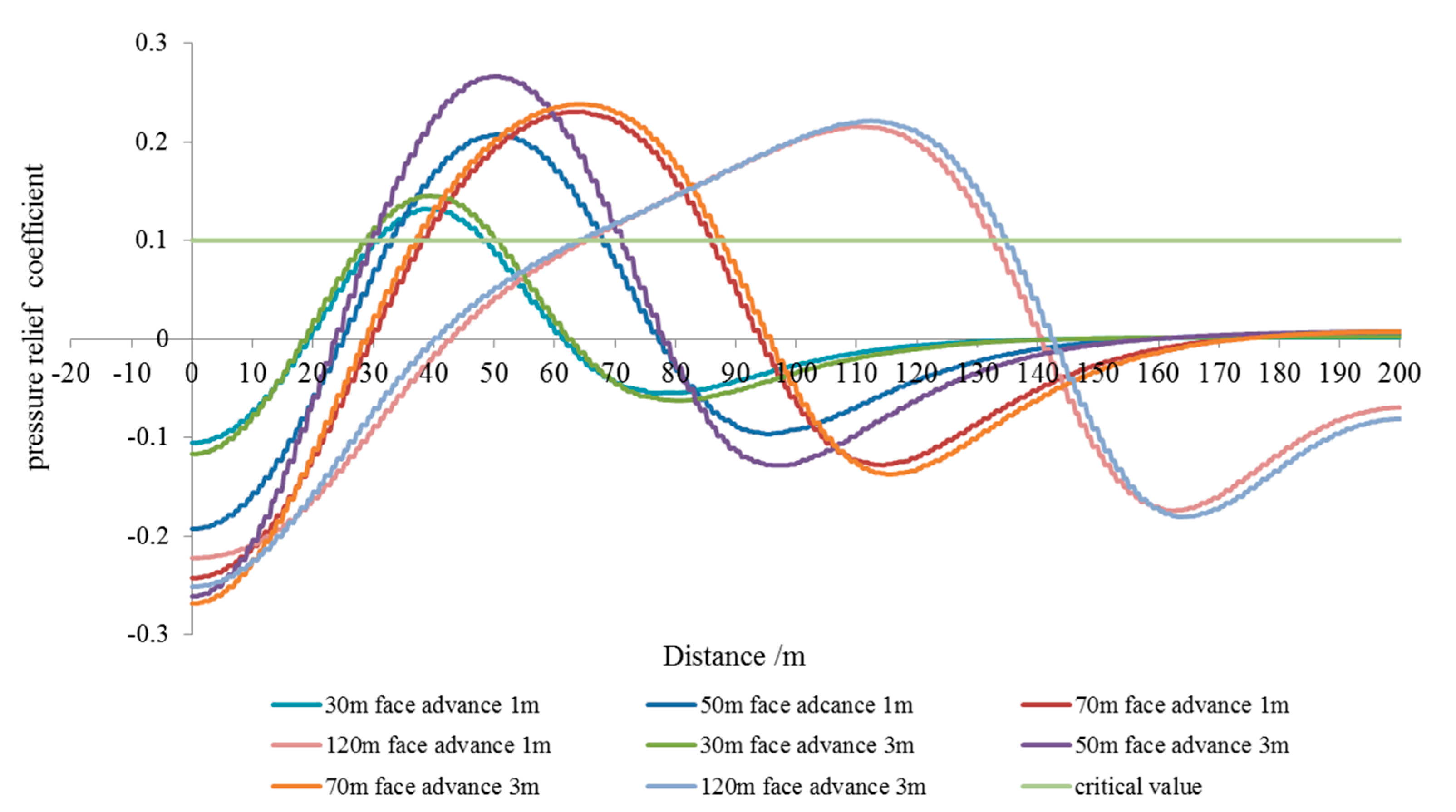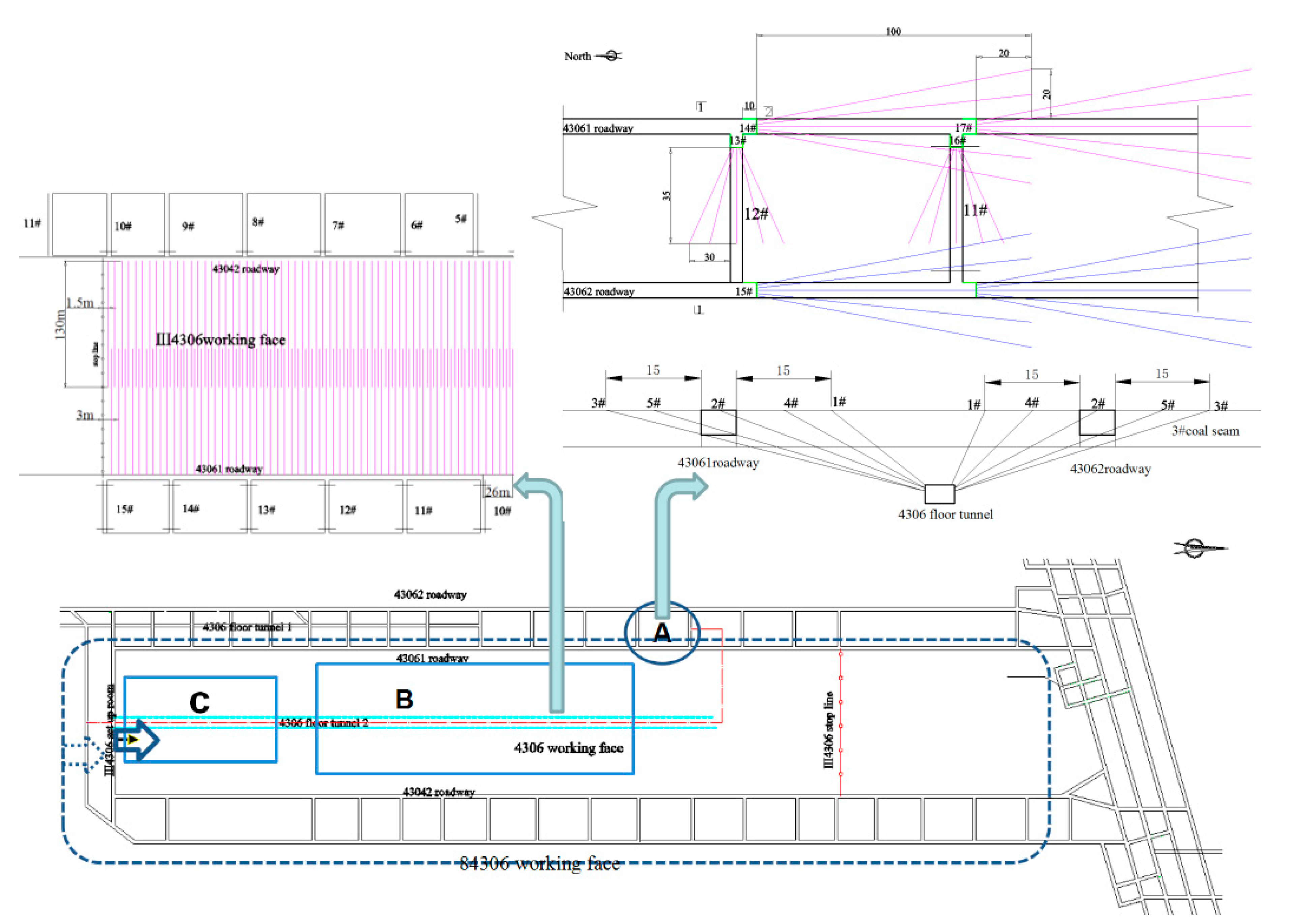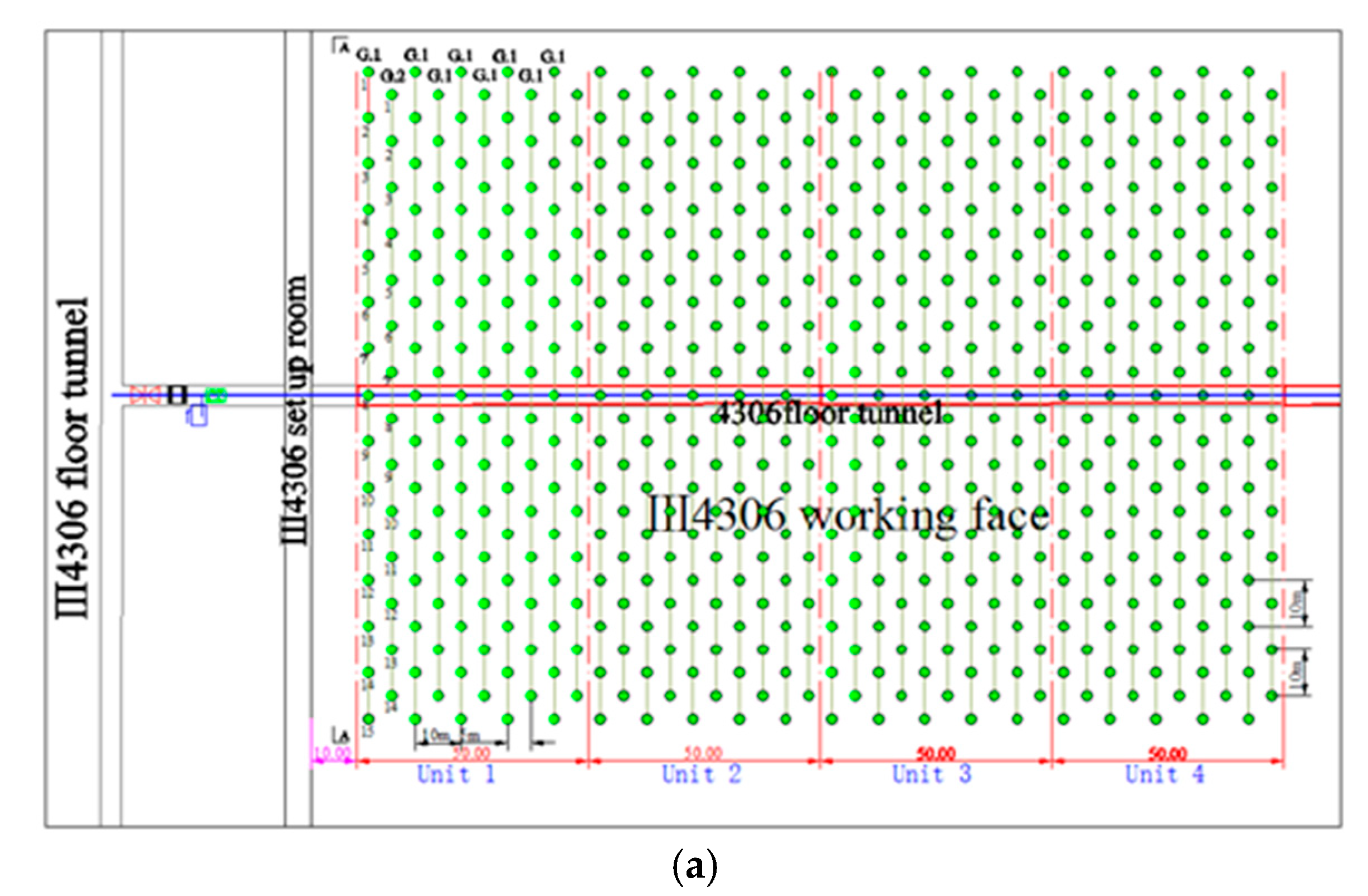1. Introduction and Background
Coal as a major energy source accounted for 62% of Chinese energy consumption in 2016. It has remained the most important fuel in China’s energy mix for the last few decades [
1]. In recent years, the safety situation of Chinese coal industry has improved, but gas and coal outbursts still seriously threaten coal mine safety due to the fact that the mining depth increases at a rate of 30–50 m/year in China [
2]. According to statistical data, the death toll of coal miners reached up to 608 in 76 gas accidents from 2012 to 2015 [
3]. Additional effective measures and research, hence, should be carried out to reduce and avoid gas disasters in China.
Stress redistribution and rock mass fracture are two dominant factors influencing rock mass permeability [
4,
5,
6]. Coal and rock mass permeability increases due to stress relief and mining induced fracturing [
5]. It has been reported by several researchers at both laboratory and field scales [
1,
2,
3,
4,
7]. A great deal of previous work showed that changes in coal permeability is induced by changes in the confining stress, and found an exponential relationship between permeability and stress [
8]. A confining stress change of 10 MPa may result in changes in permeability with approximately one order of magnitude. Yang et al. [
9] provides a visible relationship between dimensionless permeability and multiples of the initial normal stress (see
Figure 1,
is initial normal stress,
is multiples of the initial normal stress, and
is dimensionless permeability). It shows permeability decreases with increasing normal stress. Therefore, the mining of the protective coal seam is wildly used in the multiple coal seams in China (
Figure 2). As shown in
Figure 2, the coal seam which overlies the target seam is designated as the upper protective seam, whereas the underlying coal layer is called the lower protective seam. Extraction of a protective seam results in redistribution and relieving of some of the stress around underlying or overlying rock mass, thereby establishing new stress equilibrium [
10]. Reestablishment of a new stress state will inevitably lead to the changes of structure and properties of rock masses, which will eventually promote the desorption rate of gas from coal matrix and considerably increase permeability in the target coal seam or strata with high gas content.
2. Objective of Research
Stress relief coefficient and pressure relief angles are introduced by authors of this paper to evaluate the influence of lower protective excavation on its upper protected coal seam. The location of the protective layer, the horizontal butt entry and the mining height are key factors affecting the safety of protected coal seam mining [
11]. This is because the relief area in the protected coal seam depends on a variety of parameters such as: The thickness and strength of the strata between the protected coal seam and the protective coal seam, the mining thickness, gob loading behavior, face advance rate, panel width, and pillar width of the extracted protective coal seam [
11]. All of these factors should be taken into consideration to insure the safety of mining and the protected coal seam. In this paper, the mining height and gob behavior characteristics of protective coal seam are chosen as the two main factors affecting the results from protected coal seam excavation. As the effect of these two factors on the safety of mining the protected coal seam is still not clear. Therefore, an in-depth investigation on these two factors is necessitated in order to acquire the relief area in the protected coal seam and insure engineering safety. The final goal of this paper is to determine the stress relief coefficient and pressure relief angles along the strike and incline of the protective coal seam in order to locate the protection region (which is used for drilling boreholes) in the protected coal seam.
In this paper, authors attempt to develop a 3D model of two adjacent longwall faces in a physically realistic way with a consideration of gob loading behavior behind the face to improve understanding of stress distribution and stress relief not only around the protective coal seam but also in the protected coal seam after the excavation of protective coal seam (
Figure 3). The stress distribution in the gob depends on mining depth, mining speed, excavation height, bulking factor and compressive strength. Since increasing the mining speed may delay the time for the stress recovery in the gob, it is worthwhile to do some research with a consideration of different gob loading behaviors behind the face. The longwall mining method has been widely used around the world in recent years because of its most important advantage of high efficiency [
12]. A mine in Shanxi province (China) with longwall mining method is chosen for the research in this paper.
3. Literature Review on Gob Behaviors in Longwall Mining
Numerical modeling of protective coal seam mining’s influence on the protected coal seam has been extensively performed in the previous research [
1,
11]. However, gob loading characteristics have been widely ignored in their models. The authors believe that incorporating the gob loading characteristics into the model is essential for obtaining meaningful and realistic results. This is because the waste in the gob area can transfer the load from overburden to floor after the excavation of the coal seam. Ignoring load carried by the gob material will tend to increase stress concentrations in the face area and cause different stress distribution around excavation.
As the gob is inaccessible and direct measurements cannot be easily taken, it is very difficult to determine rock mass properties and stress distribution in the gob. A few techniques and research had been used and reported by previous researchers [
13,
14,
15,
16].
Figure 4 shows the strata pressure redistribution in the plane view of the seam around a longwall face after extraction. It shows that the abutment stress in coal ribs gradually recovers to the original stress state with the increasing distance from the rib-edge. The loading in the waste area gradually starts to pick up the overburden loading, and recovers its original stress at a distance from the face after the gob material can take the load from the overburden. Peng et al. [
13] studied the supporting role of the gob material by performing three-dimensional element analysis. They divided the gob into three different zones: Loosely packed zone, packed zone, and well packed zone. The side and front abutment stresses will decrease considerably because of the support offered by the compacted gob. Whittaker [
14] claimed that the cover pressure re-establishment distance is 0.3–0.4 times the coal seam depth (H) from the solid abutment (
Figure 4). Wilson et al. [
15] found that the vertical stress in the gob changes linearly, increasing from 0 at the rib to the original stress at a distance of 0.2–0.3 times the overburden depth. Whittaker and Singh [
16] assumed that the gob began to take the load at a distance of 45 m from the face, and whether the gob can recover its original stress only depended on the width of the panel. Campoli et al. [
17] investigated the longwall gob behavior in No. 3 coal seam of Pocahontas by field measurements under varying sets of geological conditions, and they found that the stress recovery distance in the gob was approximately 0.2 times of coal seam depth (360 m).
Modeling of Longwall mining with consideration of gob behaviors has also been documented in previous studies [
18,
19,
20]. In these studies, the “double yield” elements were incorporated in their simulation model and the gob was regarded as a strain-hardening material. The stress-strain response of gob material was obtained through uniaxial compression tests and displacement measurements in a laboratory test [
17]. Li et al. [
18] evaluated the stress distribution in the yield pillar and the other rib of the entry in order to find the principle for yield pillar design by Flac
3D numerical modeling. Esterhuizen et al. [
19] examined the interaction between the surrounding rock mass and typical pillar systems for different geological conditions at various spans and depths of cover by establishing Flac
2D numerical models. A method was proposed by H. Yavuz [
20] to estimate the pressure distribution in the gob of flat-lying longwall panels and cover pressure distance, and this method was verified with curves obtained through numerical models. However, all these numerical longwall models with the gob behaviors were about pillar design and stability of entries, but not for the protective coal seam mining.
Generally, gob modeling can follow two approaches, explicit model and implicit model [
21]. The explicit model needs to explicitly model the gob formation process based on the study of roof fracturing, roof caving and gob development in response to coal mining, while the implicit simulates the effect of the gob on the stability of surrounding coal mine entries and pillars, making sure that the both load redistribution to the surrounding rock and the large-scale overburden defection and subsidence are correct. Both the double-yield model and gob loading model belong to the second approach [
4]. This paper addresses the second method. Alternatively, setting up a large-scale model is capable of avoiding simulating the complex material behavior that corresponds the response curve, and equivalent gob stress distribution can be created by simply following the gob response curve. The gob load model has been used in Abbasi et al. [
22] work with Flac
3D. They estimated the overall gob mechanical behavior by comparing model outputs with field measurements at several points around a longwall face in a coal mine of Illinois. The gob achieved pre-mining vertical stress at approximately 55 m behind the back end of the shields, and the gob load installed in the mine-out area was estimated by field measurements. The gob load varied both along and cross the face advance directions. The gob load model not only characterizes the effect of the gob on the surrounding entries and coal pillars but also simplifies the process of calculation, thus the model size was reduced with finer mesh at the area of interest. As such, in this paper, the gob load model was adopted.
6. Conclusions
The mining of protective coal seam is wildly used in the multiple coal seams in China to eliminate or at least mitigate the coal and gas outburst. In this study, a 3D numerical model has been established with a consideration of the gob loading characteristics, to make a better understanding of the mining influence of lower protective coal seam to the protected coal seam. The gob characteristics are developed by H. Yavuz’s method and calibrated by the realistic VSCF value ahead of coal face. The model can be easily changed for specific coal mine gob loading behaviors based on field measurements and has the potential to realistically model longwall mining. The stress recovering distance in the gob and mining height of protected coal seam were selected as the important variables to assess their influence on the stress relief of the protected coal seam. The stress relief coefficient and relief angle were introduced as two important parameters to evaluate the stress relief effect in different regions of the protected coal seam. Finally, the reasonable gas drainage programs were provided. The main results of this study are summarized below.
(1) “O” circle was found in the gob after the mining of protective coal seam. The area closes to pillar and coal face made up of the main macro-fractures for gas flow.
(2) The overburden of protective coal seam can be divided into 5 zones according to the distribution of stress and displacement in the mining horizon: the original zone, compression zone, expansion zone, recovering zone, and re-compacted zone; the expansion zone had largest permeability compared with other areas and was the best place for gas drainage.
(3) The peak value of VSCF ahead of coal face increased with the increase of the stress recover distance; it decreased with mining height.
(4) For the same mining height with different gob behaviors of protective coal seam, the relief angles experienced the increase, decrease and stabilization process with face advancing in the coal face side; the relief angle was almost the same in the face area for different gob behaviors, indicating that it has little effect to the pressure relief of the face area.
(5) For the same gob behaviors with different mining height of protective coal seam, the mining height of protective coal seam mainly has an effect to the protected coal seam at the beginning of the mining process. This effect decreases and becomes very little when the coal seam is mined a certain distance. And the relief angle of 3 m mining height is always larger than 1m mining height with face advancing on the face side.
(6) Pressure relief scope in protected coal seam was acquired under specific mining condition. A combination gas drainage programs were provided for the case working face. The gas content reduced from 12.41 m3/t to 7.68 m3/t in 15 m range of roadway. It effectively prevented gas and coal outburst from occurring and reduced methane emission in roadway, and raised the advancing speed at the same time. And the research results can be used to guide the scope of gas drainage and highly improve gas drainage efficiency and reduce unnecessary work. More field data need to be collected for further research.
